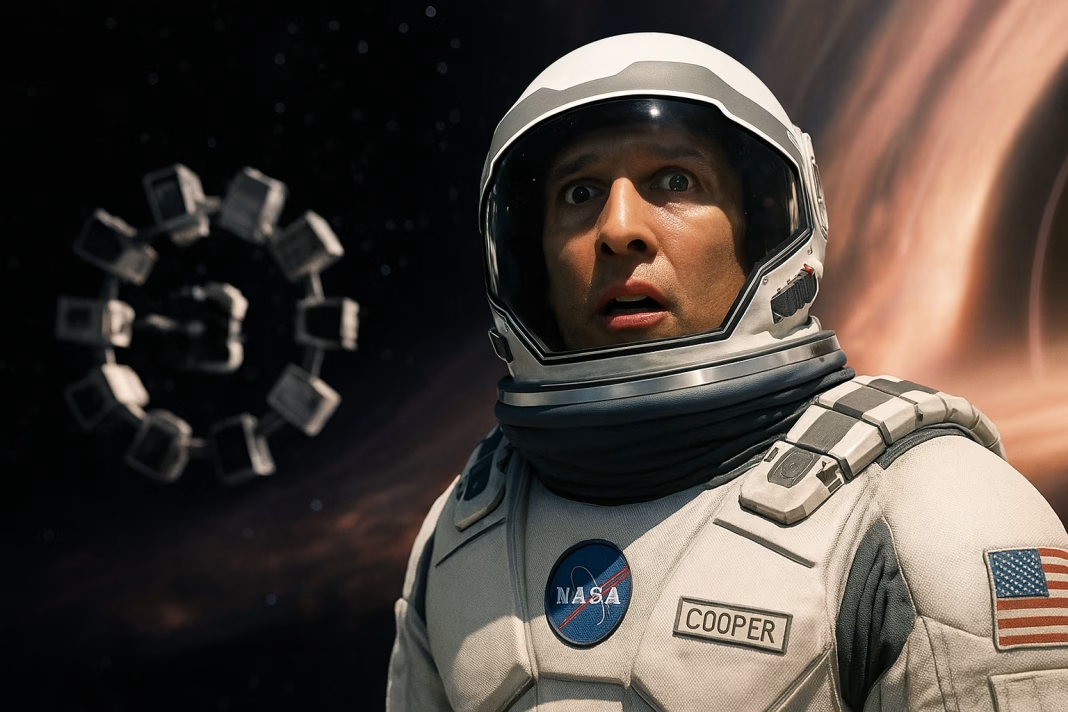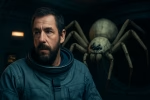Interstellar is set in a future where Earth is dying. Food is scarce, the climate is harsh, and humanity is losing hope.
A Journey to Save Humanity
In the middle of this crisis, we meet Cooper (Matthew McConaughey), a former astronaut who now lives as a farmer with his children, Murph (Mackenzie Foy) and Tom (Timothée Chalamet). Cooper is not the kind of man to simply wait for the end of the world — he’s a dreamer, a doer, and someone who believes humans are meant to explore, not just survive.
When he is given the chance to join a mission to save the human race, Cooper accepts. Alongside scientist Brand (Anne Hathaway) and crew members Doyle (Wes Bentley) and Romilly (David Gyasi), he boards the spaceship Endurance and travels through a wormhole in search of a new home for humanity. The film takes us from dusty farmlands to stunning alien worlds, each with its own dangers and mysteries.
Director Christopher Nolan uses real scientific theories, working with physicist Kip Thorne to make the film’s space travel believable. The wormholes, black holes, and strange planets are designed based on real math, but what truly makes Interstellar special is the human story at its heart. The mission is about survival, but it’s also about love, sacrifice, and the bonds between parents and children.
A Visual and Emotional Experience
One of the first things that stands out in Interstellar is how breathtaking it looks. Nolan uses huge IMAX cameras to capture both the beauty and the danger of space. The black hole, named Gargantua, is both terrifying and mesmerizing — a swirling storm of light and darkness. The alien planets are just as memorable: one is covered in dangerous, towering waves of water, while another is a frozen wasteland where even clouds turn to ice.
The spaceship Endurance is not a sleek sci-fi fantasy. It’s a practical, almost clunky-looking machine — something that feels real and functional. The robots, TARS and CASE, are also unlike anything you’ve seen before in a sci-fi film. They’re blocky, metallic, and surprisingly charming, adding moments of humor to the intense story.
But Interstellar isn’t just about the visuals — it’s about emotion. The most powerful moments aren’t the space chases or the scientific discoveries, but the scenes of Cooper thinking about his children back on Earth. One of the most heartbreaking scenes comes when Cooper realizes that because of time distortion near the black hole, years have passed on Earth while only hours have gone by for him. He watches decades of messages from his children in one sitting, seeing them grow up without him. The pain on his face is raw and unforgettable.
The relationship between Cooper and his daughter Murph is the emotional core of the film. This bond drives Cooper to keep going even when the mission becomes dangerous and uncertain. It’s a reminder that even in the vast emptiness of space, human connections are what truly matter.
Science, Philosophy, and the Human Spirit
Interstellar is packed with science — black holes, wormholes, relativity, and quantum mechanics are all part of the story. Nolan makes sure to explain enough so the audience can follow along, but sometimes the details can feel overwhelming. Still, the science is not the point of the film. It’s the backdrop for a bigger idea: the strength of the human spirit.
The movie asks big questions: How far would you go to save your family? Is survival worth more than morality? Can love really connect people across time and space? These themes are explored as the crew faces life-and-death choices, unexpected betrayals, and the possibility of never returning home.
Anne Hathaway’s character, Brand, has a controversial but heartfelt moment where she suggests that love might be a force as real as gravity — something that can guide them to the right decisions. While some might find this idea sentimental, it fits the movie’s deeper message: science can take us far, but it’s human emotions that give life meaning.
By the final act, Interstellar dives into bold, almost mind-bending territory, involving multiple dimensions and unconventional storytelling. This part can feel confusing, but it’s also where the film fully embraces its mix of science and heart. The ending is emotional, tying back to the father-daughter bond that has been at the center of the journey from the start.
Final Verdict: Interstellar is more than just a space adventure. It’s a film that blends epic visuals, complex science, and deeply personal storytelling. Christopher Nolan has created something both grand and intimate — a story about saving humanity on the biggest possible scale, but also about the love between a parent and child.
For viewers who enjoy big, thought-provoking science fiction like 2001: A Space Odyssey, this film will be unforgettable. For those who come for the visuals, it offers some of the most stunning space imagery ever put on screen. And for those who come for the emotional impact, it delivers moments that will stay with you long after the credits roll.
It’s brainy, beautiful, and heartfelt — a rare mix that makes Interstellar one of the most memorable sci-fi films of the decade.





